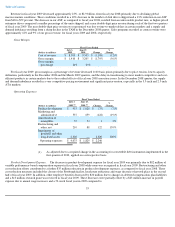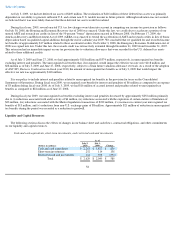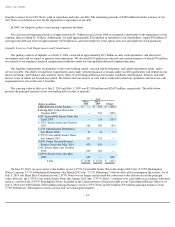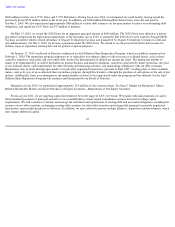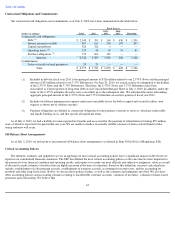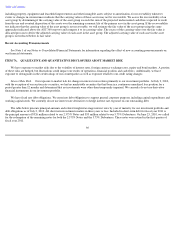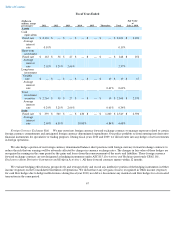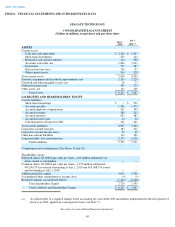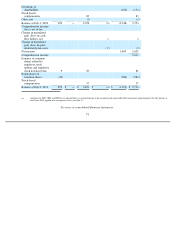Seagate 2009 Annual Report Download - page 67
Download and view the complete annual report
Please find page 67 of the 2009 Seagate annual report below. You can navigate through the pages in the report by either clicking on the pages listed below, or by using the keyword search tool below to find specific information within the annual report.
Table of Contents
The actual results with regard to warranty expenditures could have an adverse or favorable effect on our results of operations if the actual
rate of unit failure, the cost to repair a unit, or the actual cost required to satisfy customer compensatory claims differ from those we used in
determining the warranty accrual. Since we typically outsource our warranty repairs, our repair cost is subject to periodic negotiations with
vendors and may vary from our estimates. We also exercise judgment in estimating our ability to sell certain repaired disk drives. To the extent
such sales fall below our forecast, warranty cost will be adversely impacted.
We review our warranty accrual quarterly for products shipped in prior periods and which are still under warranty. Any changes in the
estimates underlying the accrual may result in adjustments that impact the current period gross margins and income. Since fiscal year 2008,
favorable or unfavorable changes in estimates of prior warranty accruals have approximated 0.5% or less of revenue. Our warranty cost was
2.2% and 2.4% of revenue during fiscal years 2008 and 2009, respectively. Changes in anticipated failure rates of specific products and
significant changes in repair or replacement costs have historically been the major reasons for significant changes in prior estimates. In fiscal
year 2010, the cost of new warranties issued (exclusive of the impact of any adjustment to prior warranty liabilities) was close to the historical
range and amounted to approximately 1.8% of revenue, but total warranty cost decreased to 1.3% of revenue, which is at the low end of the
historical range. The decrease in total warranty cost for fiscal year 2010 was due to a favorable adjustment to pre-
existing liabilities as a result of
changing to a lower cost repair vendor, other efforts to better leverage our warranty service infrastructure, and lower product failure rates. Any
future changes in failure rates of certain products as well as in repair or replacement costs may result in increased warranty accruals.
Accounting for Income Taxes.
We account for income taxes pursuant to Accounting Standards Codification (ASC) Topic 740 (ASC 740),
Income Taxes
(previously Statement of Financial Accounting Standards (SFAS) No. 109, Accounting for Income Taxes) . In applying, ASC 740,
we make certain estimates and judgments in determining income tax expense for financial statement purposes. These estimates and judgments
occur in the calculation of tax credits, recognition of income and deductions and calculation of specific tax assets and liabilities, which arise
from differences in the timing of recognition of revenue and expense for tax and financial statement purposes, as well as tax liabilities associated
with uncertain tax positions. The calculation of tax liabilities involves uncertainties in the application of complex tax rules and the potential for
future adjustment of our uncertain tax positions by the Internal Revenue Service or other tax jurisdictions. If estimates of these tax liabilities are
greater or less than actual results, an additional tax benefit or provision will result. The deferred tax assets we record each period depend
primarily on our ability to generate future taxable income in the United States and certain non-U.S. jurisdictions. Each period, we evaluate the
need for a valuation allowance for our deferred tax assets and, if necessary, we adjust the valuation allowance so that net deferred tax assets are
recorded only to the extent we conclude it is more likely than not that these deferred tax assets will be realized. If our outlook for future taxable
income changes significantly, our assessment of the need for a valuation allowance may also change.
As a result of improvements in the outlook for our future U.S. taxable income, we completed a reassessment of our valuation allowance
against U.S. deferred tax assets. In the June 2010 quarter, we decreased the valuation allowance against our U.S. deferred tax assets.
Accounting for Goodwill, and Other Long-lived Assets. We account for goodwill in accordance with ASC 350, Intangibles—Goodwill
and Other (previously SFAS No. 142, Goodwill and Other Intangible Assets ). As required by ASC 350, we test goodwill of our reporting units
annually during our fourth quarter or whenever events occur or circumstances change, such as an adverse change in business climate or a decline
in the overall industry, that would more likely than not reduce the fair value of a reporting unit below its carrying amount.
In accordance with ASC 360-05-4, Impairment or Disposal of Long-lived Assets (previously SFAS No. 144,
Accounting for the Impairment
or Disposal of Long-lived Assets ), we test other long-lived assets,
65


